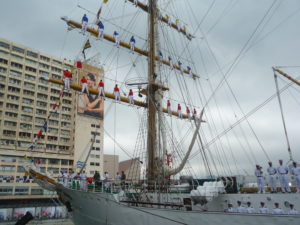
Trying to learn the rop
After setting sail on 3 May 2013, the 1,300-ton vessel began its 73rd training cruise spanning 23,809 nautical miles and 12 foreign ports in just 218 days. No sooner had Gloria made her impressive entrance at Ocean Terminal, Victoria Harbour on 23rd August, than HR Magazine climbed onboard to catch a glimpse into life at sea for the budding future officers of the Colombian Navy who are currently training on the tides.
All hands on deck
When we spoke with the cadets about their nautical learning experience, one message rang loud and clear—training onboard Gloria is not for the faint-hearted. They explained that under the command of Captain, CN. Miguel Angel Cifuentes Montealegre, all 80 cadets must train in several disciplines; from seamanship and navigation, through to electronics and astronomy, which they are later tested on. Obeying a rigorous daily schedule—consisting of studying theory from 8am to 2pm and carrying out practical duties from 2pm until midnight—it seems they are certainly put through their paces.
One such cadet is 21-year-old Lucas Wessel who has been studying a four-year long course in electronic engineering at the Almirante Padilla Naval Academy in Colombia, with the principle objective of working on warships. Commenting on his own training experience, Wessel explained, “For me training on the ship is not easy but it’s my passion. Although we study at the navy academy before we come on to the ship to train, adjusting to life onboard can be difficult, such as overcoming the initial seasickness.”
Choppy waters
Along with the challenge of sticking to a rigorous and grueling training schedule, there are also times when life at sea can become quite dangerous and cadets must conjure up the bravery to carry out their duties in the toughest of conditions. Wessel recounted a week-long tropical storm that Gloria and its crew recently encountered off the shore of Malaysia, which not only pushed cadets to their limits, but also the officials leading them.
Peruvian-born Captain Jose Carlo Montoya Ruibal, one of seven officials invited from various countries around South America to facilitate training onboard, explained that such natural occurrences are a true test of bravery. He stressed that courage is the most important asset for any young cadet undergoing military training at sea and explained, “The most difficult thing for cadets, in my opinion, is to get out there when the sea is heavy and the winds are blowing at 30 knots—that requires a lot of courage. Anyone can study and remember the theory and pass the test but not everyone can muster up the courage and face the reality of the situation when it hits.”
The sea’s the limit
But is this all worth the danger? According to Wessel and Ruibal, it is. For Wessel, being a cadet satisfies his desire to travel the world and visit other countries and learn about different cultures, whilst bringing him ever more closer to his life-long dream of working onboard warships. Ruibal, on the reverse side, believes that having the opportunity to lead the next generation of navy officials and give them courage that the service they are performing for their country is brave and noble, is irreplaceable.
Ruibal also stressed that when it comes to life at sea, the learning experience is never over, but rather limitless, as there is always more to be learnt, not only in terms of the practical side of learning and the unforeseen, but also in terms of life experience and interacting with co-workers. He explained, “When you live onboard such a huge vessel with such a large number of crew members—154 in total including officers from Colombia, Ecuador, Mexico, Chile and Peru— you learn to adapt to working in close proximity with so many people and appreciate the true value and importance of team work. If one person does not play their part, even one, the whole team will suffer. It’s just like a game of sport, we have to think and act like a team, always.”
It certainly appears that the crew onboard Gloria make a successful team having already conquered eight ports in just under four months on what will be the ship’s fifth longest cruise in history. But with Korea, Japan, and Panama left on the list of destinations to reach before returning to Cartagena in December this year, the journey is far from over for the young cadets and there is still much more to learn.
Facts about “Gloria”
- "ARC Gloria", is one of the world's largest three mast sailing training ships;
- "A.R.C. Gloria" has been in service since December 1967;
- The ship has a displacement of 1,300 tons, is 76 meters long, 10.6 meters wide, 40 meters high masts, and 1,400 square sail area offers speeds of up to 13 knots per hour;
- The ARC "Gloria" has sailed 768,065 nautical miles equivalent to 111 trips around the world;
- When the actual President of Colombia, Juan Manuel Santos, was a cadet at the Colombian Navy, he also took his training onboard of “ARC Gloria”;
- "ARC Gloria" has a special crew member- a one-year-old black hound named "Black Pearl" and this is its first voyage since it has been certified.





